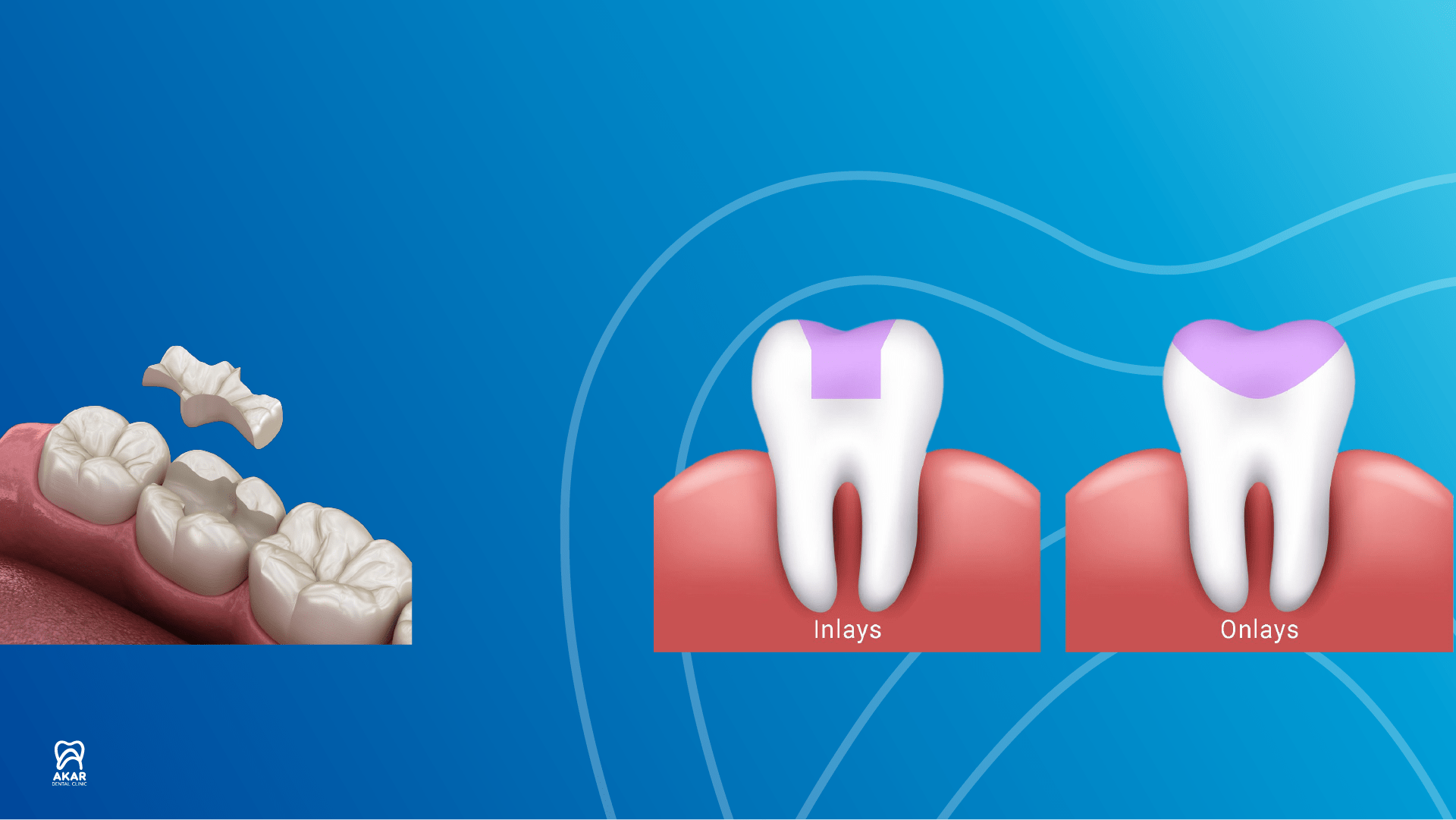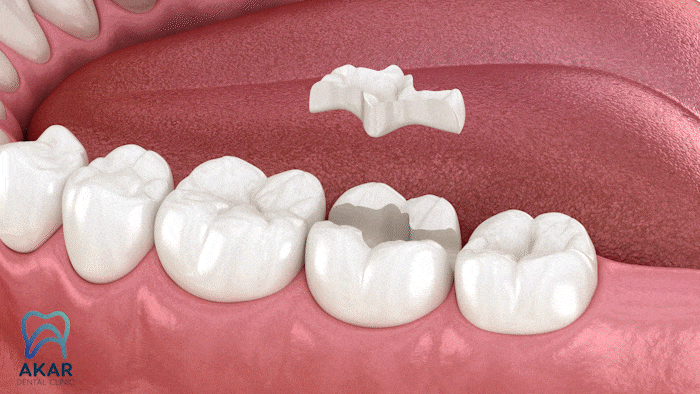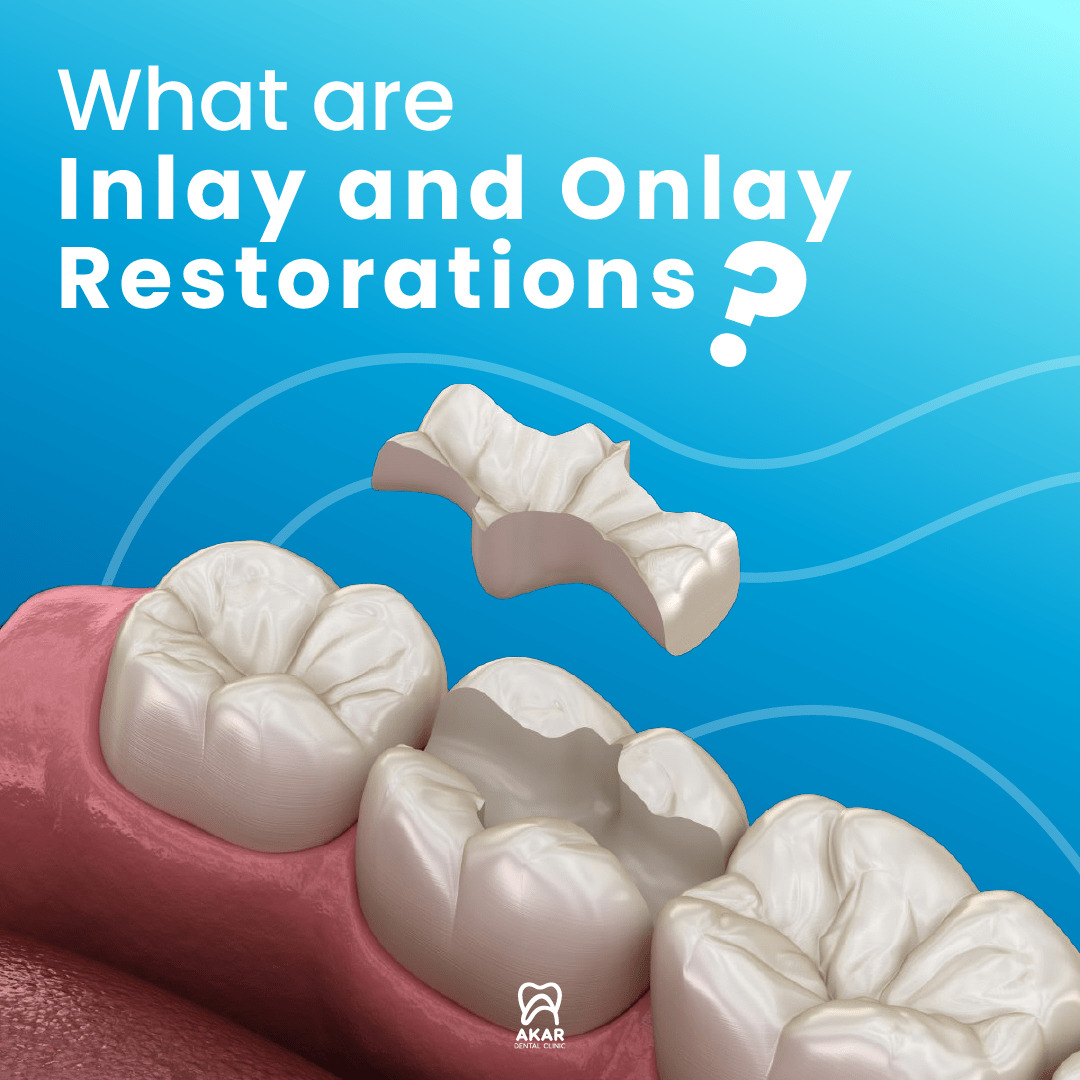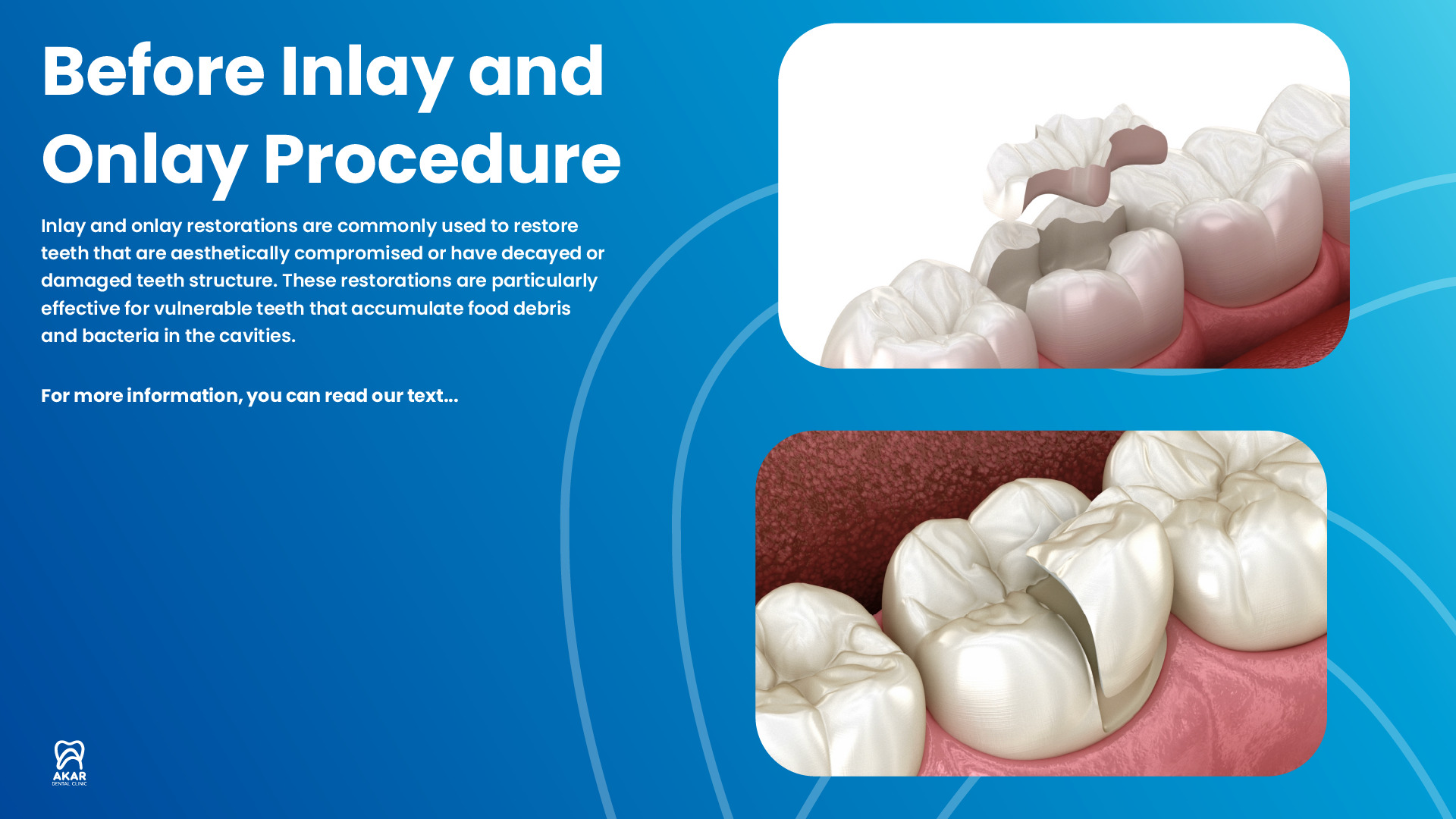

 Inlay and onlay restorations are custom-made fillings that repair damaged or decayed teeth. These fillings also provide a strong and aesthetically pleasing solution that preserves the natural tooth structure. Inlay restorations are used for cavities inside the tooth. In contrast, onlay restorations are used for larger areas of decay or damage that extend to the cusps or upper surface of the tooth.
Inlay and onlay restorations are custom-made fillings that repair damaged or decayed teeth. These fillings also provide a strong and aesthetically pleasing solution that preserves the natural tooth structure. Inlay restorations are used for cavities inside the tooth. In contrast, onlay restorations are used for larger areas of decay or damage that extend to the cusps or upper surface of the tooth.
Inlay and onlay restorations, also known as indirect fillings, provide maximum dental protection and compatibility with the natural oral structure while making it easier to maintain good oral hygiene. They are a popular choice for patients looking for a long-lasting, aesthetically pleasing solution that protects their oral health and preserves the natural look and feel of their teeth.
What are Inlay and Onlay Restorations?
 Inlay and onlay restorations are cosmetic methods of indirect fillings used to restore damaged teeth. While they share a standard treatment method, they differ in the amount of tooth structure they cover. Onlays treat more prominent areas of decay that stretch to the cusps or upper surface of the tooth, whereas inlays are used to treat cavities inside the tooth.
Inlay and onlay restorations are cosmetic methods of indirect fillings used to restore damaged teeth. While they share a standard treatment method, they differ in the amount of tooth structure they cover. Onlays treat more prominent areas of decay that stretch to the cusps or upper surface of the tooth, whereas inlays are used to treat cavities inside the tooth.
The choice between inlay and onlay restorations depends on the extent and location of the damage, as well as the patient’s dental needs and preferences. These restorations not only provide a strong and long-lasting solution, but they also minimize tooth discoloration and preserve the natural tooth structure.
The Inlay restoration process is a dental treatment that helps prevent the formation of cavities inside the tooth and prevents bacteria from entering the tooth. It involves the placement of a custom-made filling on the inner surface of a damaged or decayed tooth. Inlay fillings are an ideal choice for repairing adjacent teeth, as they can be precisely molded to fit the contours of the tooth.
Onlay restorations are more extensive than inlay restorations, as they aim to protect a larger portion of the tooth’s surface. The onlay restoration process also requires two clinic visits, with the damaged tooth tissue removed during the first visit and a temporary filling placed.
The first visit for both types of fillings includes cleaning the decayed or damaged area of the teeth and taking dental impressions of the filling area. Next, any possibility of sensitivity that the patients may have is prevented with the temporary tooth that they will use until second visits. After these steps, dental impressions are sent to the lab where cosmetic fillings are produced by the professionals designers and technicians. On second visits the trials part for fillings is performed by the dentist. Once the permanent inlay and onlay filling has been placed, and then functional test starts, in case the requirements of function are effective, the process of Inlay and Onlay including cosmetic fillings are completed by the dentists.
Overall, inlay and onlay restorations effectively repair damaged or decayed teeth. They have a variety of materials they can use, like zirconium, porcelain, resin, composites, or gold, which all provide a strong and natural-looking solution.The main purpose for patients who would like Inlay and Onlay restoration for their teeth associated with this type of restoration that has both durability and aesthetic view that ensures the natural looking like patients’ own teeth, compared to the traditional filling methods.
Types of Inlays and Onlays
Patients have a variety of materials to choose from for their inlay and onlay restoration treatments, including zirconium, porcelain, ceramic, and composite. Types of restoration are defined based on usage goals, such as aesthetics, functionality, or both, according to the patient’s needs and desires.
Zirconium, for example, is popular for its strength and ability to blend in with natural teeth. Porcelain and ceramic are also commonly used due to their durability and appearance, which match the patient’s own teeth color. Composite resin is a versatile option that can be color-matched to the patient’s existing teeth, providing a seamless and natural-looking restoration.
In addition to material options, there are direct and indirect inlay and onlay types. The dentist prepares direct restorations in one visit, while indirect restorations require a laboratory to fabricate them, typically requiring two trips.
-
Zirconium
Zirconium-based restorations are highly durable for chewing pressure and aesthetic views. Its white color makes it highly compatible with natural teeth, resulting in a seamless blend. This material is ideal for inlay and onlay restorations due to its strength and aesthetic properties, providing long-lasting and visually pleasing results.
-
Porcelain
Porcelain restoration is popular for front teeth, due to its natural appearance and ability to blend seamlessly with the surrounding teeth. While it may not be as strong as zirconium, it is still durable and can withstand normal wear and tear. However, it is important to note that there are different types of porcelain restorations, some of which may include a metal substructure.
For the crown treatment, it may not be a perfect option for patients because it includes a metal supported system shaping all around the teeth, that may be seen as a metal part, between gum and crown. On the other hand, porcelain crowns are not durable as much as the zirconium crowns, but also sometimes provide good benefits for different types of complaints specific to patients.
However, porcelain materials are used for different types of dental treatment solutions such as aesthetic and functionality depending on what patients need and expect from their dental treatment, too. It is important to note that patients should be sure that the information which they get is provided by the right address, due to the fact that there are different types of dental solutions, determined based on what patients need.
-
Ceramic
Ceramic inlay and onlay restorations may be ideal for achieving a cavity floor parallel to the tubercle slopes. These restorations are highly preferred for their superior aesthetics, and when used in conjunction with resin cement, they minimize the occurrence of micro-wear. Ceramic restorations are durable, and they can withstand the pressure exerted during chewing. Overall, they are compatible with the natural tooth color and can blend seamlessly with adjacent teeth.
-
Composite
Composite fillings are an excellent choice for restoring teeth because they are highly durable,and are used from the start of the filling process in a time that can last a lifetime. They are available in white or amalgam and offer superior strength compared to the other types of restorations in terms of long-term usage.
The Differences Between Inlay and Onlay
 An inlay is a technique used to close gaps that have developed in the tooth’s inner cavity that can not reach the tooth’s external line. Onlay is an alternative to the Inlays with the filling method which can be applied to repair damage or cavities located on the outer border of the tooth or the biting (upper) surface.
An inlay is a technique used to close gaps that have developed in the tooth’s inner cavity that can not reach the tooth’s external line. Onlay is an alternative to the Inlays with the filling method which can be applied to repair damage or cavities located on the outer border of the tooth or the biting (upper) surface.
Before Inlay and Onlay Procedure
 Inlay and onlay restorations are commonly used to restore teeth that are aesthetically compromised or have decayed or damaged teeth structure. These restorations are particularly effective for vulnerable teeth that accumulate food debris and bacteria in the cavities.
Inlay and onlay restorations are commonly used to restore teeth that are aesthetically compromised or have decayed or damaged teeth structure. These restorations are particularly effective for vulnerable teeth that accumulate food debris and bacteria in the cavities.
Cavities can cause tooth pain and sometimes cause nerve damage that may require root canal treatment. Poor dental hygiene and inflammation around the tooth are common signs. Restoration can sometimes be used instead of endodontic treatment, such as post-restoration or crown lengthening on teeth where a retentive form is challenging to create.
After Inlay and Onlay Procedure
Inlay and onlay restorations offer many advantages over traditional dental fillings. They resist water absorption and abrasion, and their poor thermal conductivity makes them more comfortable. These restorations can increase the strength of the treated tooth, and promote better periodontal health by preventing plaque accumulation.
Who is Suitable for Inlay and Onlay?
 The suitability of inlay and onlay restorations for patients depends on their oral hygiene and the condition of their teeth. Patients who clench their teeth may require specific filling materials to prevent damage, while those with poor oral hygiene may benefit more from full crowns. Carefully evaluating each patient’s unique needs are important to determining which treatment should be chosen.
The suitability of inlay and onlay restorations for patients depends on their oral hygiene and the condition of their teeth. Patients who clench their teeth may require specific filling materials to prevent damage, while those with poor oral hygiene may benefit more from full crowns. Carefully evaluating each patient’s unique needs are important to determining which treatment should be chosen.
For cavities that are less than 1.5 millimeters deep, the composite filling material is typically used; however, for teeth with insufficient dental tissue, other treatment options may be required. Ceramic restorations, on the other hand, are not recommended if moisture control can not be maintained in the mouth.
In cases where an inlay or onlay restoration is appropriate, the patient’s history and dental imaging, such as Tomography or X-rays, help determine the best course of treatment. This information can also help identify any metal allergies or habits that may impact the success of the restoration.
Advantages of Inlay and Onlay Restorations
Compared to conventional dental fillings, inlays and onlays cosmetic restorations have the following benefits:
-
Improved Strength:
Inlay and onlay restorations are made from high-strength materials that can improve the overall strength of the treated tooth.
-
Durability:
Inlays and onlays are more durable than traditional fillings and can last up to 15-20 years or more with proper care.
-
Aesthetics:
Cosmetic filling type Inlays and onlays are the aesthetic solution differentiated from typical amalgam filling implementation due to their color, designed to match the natural tooth color.
-
Better Fit:
Inlays and onlays are custom-made to fit the specific contours of the treated tooth, providing a better fit than traditional fillings.
-
Preservation of Healthy Tooth Structure:
Inlays and onlays require the removal of less healthy tooth structure than traditional fillings, helping preserve more of the natural tooth.
-
Preventing Further Damage:
Inlay and onlay restorations can protect the tooth from further damage, such as cracking or chipping, and can be used to replace old or failing restorations.
Thanks to the restoration process, the procedure is performed without damaging the intact part of the tooth and preserves its original state. At the same time, aesthetically, it is also possible to overcome discoloration to get the form of appearance of natural teeth through Inlay and Onlay cosmetic restorations.
Why Choose Turkey for Inlay and Onlay?
At Akar Dental, the highest dental care in Turkey is committed to patients worldwide, including a treatment warranty provided by our clinic. Our team of experts uses advanced techniques and personalized treatment plans to ensure for every patient to receive the best possible care. In our clinic, the treatment plans are prepared by our head dentist with the help of high-tech implementations such as Tomography and X-ray giving deep details of dental structure of patients. This gives our head dentist ideas about the jawbone, and deep tooth regarding the root, that completely determines the treatment plan.Our state-of-the-art clinic has the latest technology, so you can be sure you’re receiving the most advanced treatments.
While our dental treatments present the best options with high-tech solutions, we also ensure that you will not be faced with extra costs. By contacting us, you can schedule your Inlay and Onlay restorations in Turkey and experience the best dental care at Akar Dental.
Inlay and onlay fillings are completely safe. Due to the use of amalgam fillings and fillings that are more compatible with health, these forms of restoration are extremely advantageous both aesthetically and in terms of preserving the original tooth.
Ceramic filling procedures require two clinic visits, and the treatment is completed within three months. Ceramic fillings can be used for a very long time as long as they are well cared for by the patient and treated sensitively.
Onlay fillings have a very low chance of falling out. The fall-off condition does not occur during the onlay and inlay restoration procedures that we perform in our clinic using the most appropriate techniques and materials.
The onlay process is more practical than composite fillings, but to use onlay instead of composite fillings, the dental nerves and structure must be intact and healthy.
An inlay restoration is a custom-made filling that fits inside the tooth’s cusps or bumps. Inlays are typically used to treat larger cavities or decay that has affected the tooth’s chewing surface.
An onlay restoration is a custom-made filling that covers the tooth’s cusps and part of the chewing surface. Onlays are typically used to treat decay that has spread beyond the tooth’s cusps.
Inlay and onlay restorations can be made from various materials, including zirconium, porcelain, composite resin, and gold.
With proper care, inlay and onlay restorations can last many years, often 10–20 years or more.
The placement of an inlay or onlay restoration typically involves two appointments. Dentists prepare the tooth so that treatment will be implemented by removing the decay. Next, an impression is taken during the first clinic visit according to the area where the cosmetic materials will be applied. On the second visit, prepared cosmetic materials that connect with your tooth color in the lab are placed in or on the related area, and the process is finished.
Inlay and onlay restorations may be more expensive than traditional fillings due to their custom-made nature and the materials used.
You can contact us to get more information about our oral and dental health treatments and the opportunities we offer.